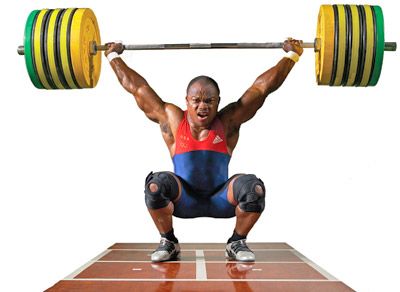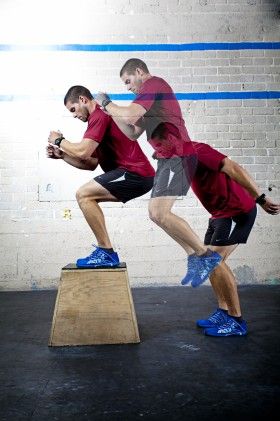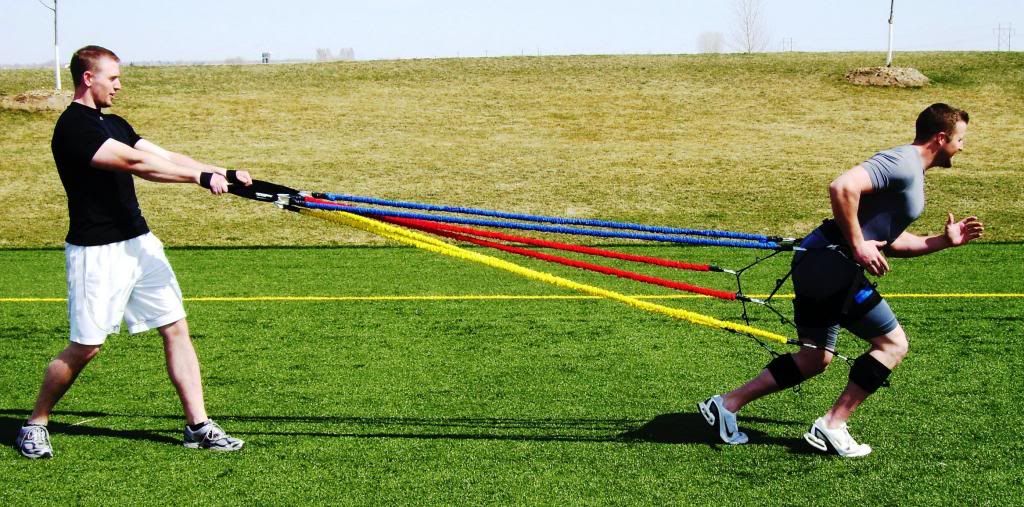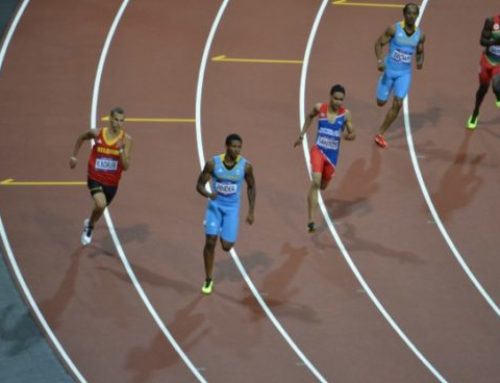How to Build Fast Muscle: A Fundamental Approach
Building fast muscle does not require performing some crazy routine you’ve never heard of. The standards for increasing power have been well established through decades of research and experimentation. Once you understand the concepts and develop the right mindset, you can easily become a more powerful athlete.
The key to building fast muscle is to activate your central nervous system (CNS). The CNS plans, initiates and coordinates all human movement.[1] With higher CNS activation, you will recruit more muscle fibers and motor units, helping you produce force faster. To do this, you need to use training methods that arouse the CNS’s “fight or flight” mechanism.
Heavy Strength Training (HST)

HST Outline
- Recruits large motor units
- High force development
- High intensity (60-90% of max) and low reps (1-5)
- Adequate rest (3-5 minutes)
Plyometrics
Plyo training is the perfect complement to HST, because it focuses on the speed of a muscle contraction. You apply maximum force into the ground, object or weight in as short a time as possible.[3] This teaches your muscles to store and quickly release energy in a fast and explosive contraction, which directly improves sprinting, jumping and other sports skills.
If used progressively, plyos allow you to build, or sustain, fast muscle characteristics for your particular sport. In addition, using bodyweight loads allows you to perform plyos up to three times per week. (Find all the plyo exercises you need in STACK’s Plyometrics Guide.)
Plyo Outline
- Fast and forceful muscle contraction
- High intensity (max effort) and low load (body weight)
- Adequate rest (3-5 times longer than the exercise)
Speed-Specific Loading (SSL)
SSL involves high-velocity resisted movements such as Olympic, resistance band, med ball or weight vest exercises. Compared to HST, smaller loads are used because speed is critical. A 2002 study found that using 10 to 30 percent of your max to perform at max speed significantly increases the speed of muscle contraction.[4]
It’s especially important to stay on the lower end of this range when performing sport-specific movements, so the resistance does not affect your technique. Always finish a sport-specific movement with a set with no resistance to feel the effect of the training load.
SSL Outline
- Low load, high velocity
- 10-30% max
- Perfect technique
Putting It Together
The fundamentals of building fast muscle involve performing fast movements under both high and low loads. HST develops high threshold muscle fibers needed for force application, while plyos and SSL provide high movement velocity to develop fast muscle contractions. Although nervous system adaptations and muscle physiology changes are important, psychological intention to move a resistance fast may be the decisive factor in building fast muscle.
References
[1] Wilmore, JH and Costill, DL. (2004). Physiology of Sport and Exercise. 3rd Edition. Human Kinetics. [2] Behm, D. G., & Sale, D. G. (1993). “Velocity specificity of resistance training.” Sports medicine (Auckland, NZ), 15(6), 374. [3] Dintiman, G & Ward, B. (2003). Sports Speed. 3rd Edition. Human Kinetics. [4] McBride, JM, et al. (2002). “The effect of heavy- vs. light-load jump squats on the development of strength, power, and speed.” J. Strength Cond. Res. 16(1): 75-82.Photo: otecrossfit.com
RECOMMENDED FOR YOU
MOST POPULAR
How to Build Fast Muscle: A Fundamental Approach
Building fast muscle does not require performing some crazy routine you’ve never heard of. The standards for increasing power have been well established through decades of research and experimentation. Once you understand the concepts and develop the right mindset, you can easily become a more powerful athlete.
The key to building fast muscle is to activate your central nervous system (CNS). The CNS plans, initiates and coordinates all human movement.[1] With higher CNS activation, you will recruit more muscle fibers and motor units, helping you produce force faster. To do this, you need to use training methods that arouse the CNS’s “fight or flight” mechanism.
Heavy Strength Training (HST)

HST Outline
- Recruits large motor units
- High force development
- High intensity (60-90% of max) and low reps (1-5)
- Adequate rest (3-5 minutes)
Plyometrics
Plyo training is the perfect complement to HST, because it focuses on the speed of a muscle contraction. You apply maximum force into the ground, object or weight in as short a time as possible.[3] This teaches your muscles to store and quickly release energy in a fast and explosive contraction, which directly improves sprinting, jumping and other sports skills.
If used progressively, plyos allow you to build, or sustain, fast muscle characteristics for your particular sport. In addition, using bodyweight loads allows you to perform plyos up to three times per week. (Find all the plyo exercises you need in STACK’s Plyometrics Guide.)
Plyo Outline
- Fast and forceful muscle contraction
- High intensity (max effort) and low load (body weight)
- Adequate rest (3-5 times longer than the exercise)
Speed-Specific Loading (SSL)
SSL involves high-velocity resisted movements such as Olympic, resistance band, med ball or weight vest exercises. Compared to HST, smaller loads are used because speed is critical. A 2002 study found that using 10 to 30 percent of your max to perform at max speed significantly increases the speed of muscle contraction.[4]
It’s especially important to stay on the lower end of this range when performing sport-specific movements, so the resistance does not affect your technique. Always finish a sport-specific movement with a set with no resistance to feel the effect of the training load.
SSL Outline
- Low load, high velocity
- 10-30% max
- Perfect technique
Putting It Together
The fundamentals of building fast muscle involve performing fast movements under both high and low loads. HST develops high threshold muscle fibers needed for force application, while plyos and SSL provide high movement velocity to develop fast muscle contractions. Although nervous system adaptations and muscle physiology changes are important, psychological intention to move a resistance fast may be the decisive factor in building fast muscle.
References
[1] Wilmore, JH and Costill, DL. (2004). Physiology of Sport and Exercise. 3rd Edition. Human Kinetics. [2] Behm, D. G., & Sale, D. G. (1993). “Velocity specificity of resistance training.” Sports medicine (Auckland, NZ), 15(6), 374. [3] Dintiman, G & Ward, B. (2003). Sports Speed. 3rd Edition. Human Kinetics. [4] McBride, JM, et al. (2002). “The effect of heavy- vs. light-load jump squats on the development of strength, power, and speed.” J. Strength Cond. Res. 16(1): 75-82.Photo: otecrossfit.com














